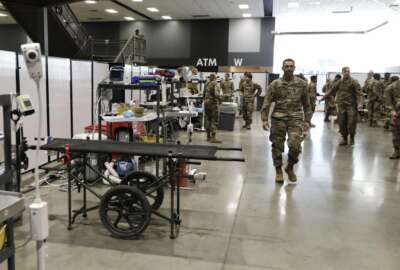Best listening experience is on Chrome, Firefox or Safari. Subscribe to Federal Drive’s daily audio interviews on Apple Podcasts or PodcastOne.
As the Defense Department continues to lift restrictions on bases and service member travel, the military, like most of the country, is falling prey to a second wave of coronavirus.
In the past month, the number of service members, contractors, civilians and military dependents diagnosed with COVID-19 has more than doubled.
On June 6, DoD reported 10,462 cases since it started reporting infections in March. As of Monday, that number has risen to 21,493.
To date, DoD has lifted restrictions on 70 of its 230 bases — about 30%.
“Unrestricted travel is allowed when a service member is moving from a ‘green’ installation to another ‘green’ installation,” DoD officials stated in a release. Green installations are ones without travel restrictions. “If either the losing or gaining installation is ‘red’ or ‘restricted,’ the service member’s travel would require to be either under the exemptions or waivers outlined in the secretary of defense memo on the conditions-based, phased approach to personnel movement.”
Under the current set of policies, DoD says movement between bases is phased, data-driven and based on each location’s condition.
Before an individual base can move from “red” to “green,” it will need to:
- Show a 14-day declining trend in symptoms and cases and be in a state that does not currently not have a stay at home order.
- Have already moved to Health Protection Condition “Bravo” or better — meaning the base is not experiencing sustained community transmission and has enough health care capacity to handle a spike in cases.
- Get approval from a military department secretary or combatant commander to lift travel restrictions, once the other conditions are met.
In some cases, “green” and “red” bases are patchworked within a particular state, because of local conditions. For example, Pennsylvania has a base closed to travel in Pittsburgh and open in the northeast part of the state.
“Decision-making is very much tied to what is happening in their local community,” Thomas McCaffery, assistant secretary of defense for health affairs said during a Pentagon press briefing last week. “The Military Health System tracks COVID-19 cases and gets reports on a daily basis, and that information is shared with the commanders on the ground to make well-informed decisions about what to do.”
Meanwhile, DoD is continuing to open up the Pentagon reservation.
“Washington Headquarters Services has cleaned over 15 million square feet of office space within the Pentagon reservation,” DoD CMO Lisa Hershman said on June 29. “I think this is probably the cleanest this building has been in a long time.”
The Pentagon is in phase two of its five-part reopening plan.
“Phase two guidelines include the use of face coverings, social distancing, identifying symptomatic personnel, as well as continued enhanced cleaning measures,” Hershman said. “WHS has created a wonderful handbook for those of us who are coming back to the Pentagon reservation, and it’s all done through the lens of the employees.”
The plan also uses supervisor-planned alternating schedules for employees.
DoD has also been trying to test more of its service members. Since April, it has been conducting tests on troops at a tiered level based on their mission importance.
The military finished its first tier of key strategic and homeland security personnel in May. DoD has the capability to test about 20,000 people a week.
Copyright
© 2024 Federal News Network. All rights reserved. This website is not intended for users located within the European Economic Area.

